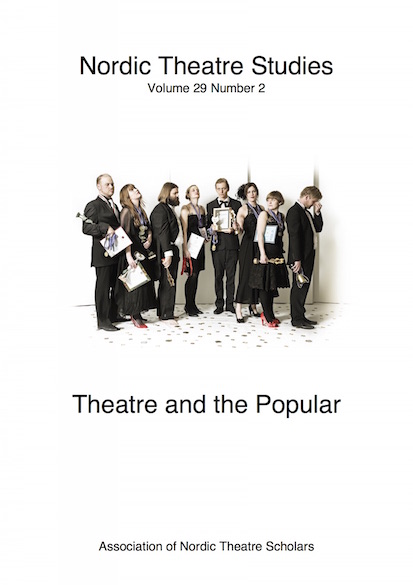How to Explain Popular to a Dead Hare
DOI:
https://doi.org/10.7146/nts.v29i2.104612Keywords:
Theatre systems, Estonian theatre, Pierre Bourdieu, Economic and symbolic capital, Audience, Theatre NO99, Tallinn City Theatre, Full gameAbstract
In this article the popular is defined with the tools of field theory by Pierre Bourdieu, that is as production with high degree of outer-field economic capital (measured with the number of visits per production). It is also claimed that on some conditions these productions do not lower the degree of autonomy of the field since theatre manages to convert the economic capital to symbolic capital (nominations for annual awards give evidence of the latter). Such a production is called the Full Game.
Based on the comparable data of new productions made in Estonia from 2010 to 2015 (1199 in total) the article will introduce a possible methodology of how to calculate the popular in theatre that considers both the number of visits per production in a year and the use of seating capacity. Following that methodology, there were only sixty-one productions during the chosen period that could be titled popular in a sense that they have a very high degree of outer-field success (these productions are visited 2,4 times more often than the average number of visits per production in one calendar year and have the attendance rate of 95% and higher). Taking into account also the inner-field specific consecration (whether they have been nominated for annual theatre awards), only twenty-three popular productions – among them just one comedy, one musical and one operetta – remain in the list of what I have called the Full Game. That is two per cent of all the new productions of the respective time period.
The list of Full Games suggests that the specific theatre, where the production is performed plays a significant role for a production to become popular. Only four theatres have had more than one Full Game in 2010–15 in Estonia and two of them – Theatre NO99 and Tallinn City Theatre – are used as case studies to find possible strategies of being popular without loosing specific consecration.References
Allik, Jaak. 2010. “Parteipilet peaks kõigil taskus olema.” Maaleht 13 May.
Allik, Jaak. 2011. “Lugu oma õnne õgivast rahvast.” Postimees 26 March.
Bourdieu, Pierre. 1993. The Field of Cultural Production. Essays on Art and Litera¬ture. Cambridge: Polity Press.
Bourdieu, Pierre. 1998. On Television. New York: The New Press.
Bourdieu, Pierre. 2003. Praktilised põhjused. Teoteooriast. Tallinn: Tänapäev.
Herkül, Kadi. 2014. “Pantalone pisaraid ei usu.” kultuur.err.ee 4 June.
van den Hoogen, Quirijn L. Performing arts and the city. Dutch municipal cultural policy in the Brave New World of evidence-based policy. Groningen: Rijksuniversiteit Groningen.
Johannes, Maris. 2013. “Tunnid Stoppardi meistriklassis.” Sirp 4 April.
Karulin, Ott. 2011. “Sõin ja jõin seal minagi.” Sirp 1 April.
Karulin, Ott. 2013. Rakvere Teater “täismängude” otsinguil aastatel 1985–2009. Tartu: Tartu University Press.
Kaus, Jan. 2010. “Eluvõitluse tühjus ime umber.” Sirp 7 January.
Kolk, Madis. 2009. “Kas loomastumine või lepitus?” Sirp 20 March.
Kolk, Madis. 2013. “Tom Stoppardi üldinimlik intellektualism.” Sirp 4 April.
Laasik, Andres. 2009. “Suur sakslase- armastus täidab tühja ruumi.” Eesti Päevaleht 14 December.
Laasik, Andres. 2011. “Kolm kuningriiki näitasid traagelniite.” Eesti Päevaleht 22 September.
Laks, Tiiu. 2010. “Ühtse Eesti suurkogu poliitikutele ei halastanud.” Eesti Päevaleht 8 May.
Laks, Tiiu and Kaarel Kressa. 2010. “Ärge oodake kogu aeg uue partei tulekut.” Eesti Päevaleht 10 May.
van Maanen, Hans. 2009. How to Study Art Worlds. On the Societal Functioning of Aesthetic Values. Amsterdam: Amsterdam University Press.
Mikomägi, Margus. 2014. “Igatsuse varjundite tundeküllus.” Maaleht 5 June.
Niineste, Mart. 2011. “Kas me sellist Eestit tahtsimegi?” Eesti Päevaleht. 26 March.
Oidsalu, Meelis. 2011. “Euroopluse origami.” Sirp. 7 October.
Prints, Kairi. 2009. “Kuidas seletada kunsti kehakultuuriministrile.” Postimees. 12 March.
Purje, Pille-Riin. 2014. “Meil ei ole õnne ega tulegi …” Sirp 19 June.
Tõnson, Margit. 2010. “Kuidas ma allusin provokatsioonile.” Eesti Ekspress 13 May.
Veidemann, Rein. 2009. “Armastuse antinoomiad.” Postimees 14 December.
Veidemann, Rein. 2014. “Palavikuline Tšehhov.” Postimees 4 June.
Downloads
Published
How to Cite
Issue
Section
License
The copyright belongs to the authors and Nordic Theatre Studies. Users can use, reuse and build upon the material published in the journal but only for non-commercial purposes. Users are allowed to link to the files, download the files, distribute the files on a local network (preferably by links), upload the files to local repositories if their institutions require them to do so, but not republish the files without proper agreements with the journal and the author.

